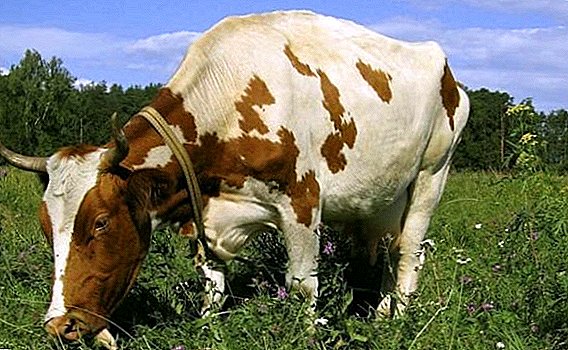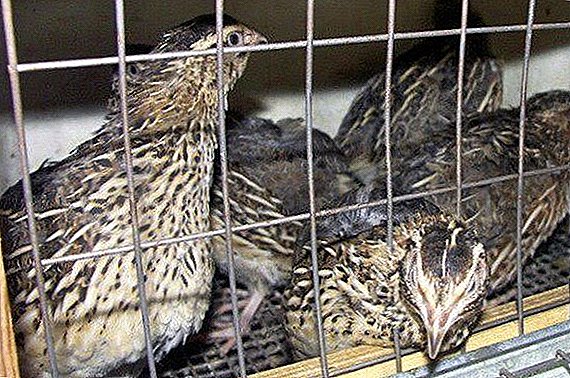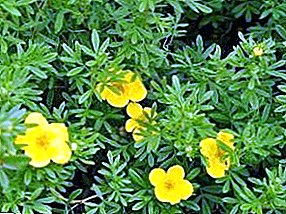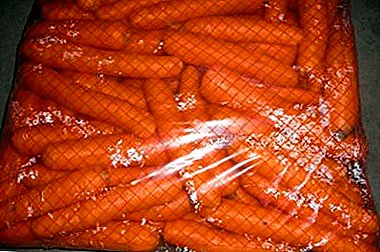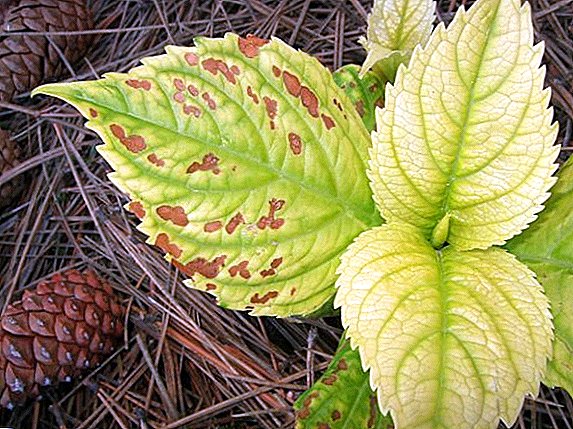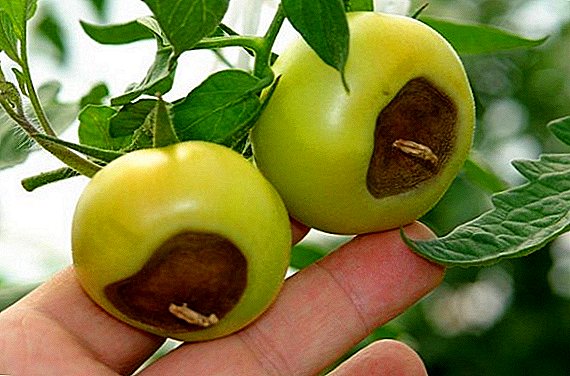 Tomatoes - the usual part of the garden landscape. Someone takes a small corner with them, while others take a lot more space for tomatoes. But all gardeners are interested in one thing: how to get rid of pests that attack plantings tirelessly. We study this question in more detail.
Tomatoes - the usual part of the garden landscape. Someone takes a small corner with them, while others take a lot more space for tomatoes. But all gardeners are interested in one thing: how to get rid of pests that attack plantings tirelessly. We study this question in more detail.
White fly
It is one of the most dangerous pests of tomato plantations. The fight against it takes a lot of time, but the use of strong drugs can speed up this process.
How does it look
Adult butterflies are very small: from 1 to 3 mm, and the larvae and the smaller. Upon closer inspection, a white body and pale beige (at a distance - pure white) wings covered with powdery pollen are visible.
What is dangerous
The insect causes triple damage to plants, namely:
- sowing on the lower part of the leaves, pulls out the juices;
- carries various viruses;
- products of excretion in the form of a brilliant bloom (also known as honeydew) create ideal conditions for the appearance of the mob, and then of the black fungus.

How to fight
Many use wide sticky traps hung over rows. But this measure is effective only at the very beginning of the raids and is more suitable for greenhouses.
Important! When buying insecticides, ask the seller how compatible the preparations are with other compounds and fertilizers.On open ground, more effective formulations are used:
- Aktara. 1.4 g of the product is diluted in 3 l of water and pour the mixture under the root. In the presence of a large population, tomatoes are also sprayed: a sachet of 10 liters of water, 3 times at weekly intervals;

- Fitoverm. 10 g / 1 l give a strong effect. Often enough and one treatment. To consolidate the results after 10-14 days, another approach is taken (but no more);

- Spark Gold. 40 g of powder is stirred in 10 l of water and applied as watering. One procedure is enough (the effect lasts 3 weeks);

- soap solution. The laundry soap is rubbed on a grater and dissolved in water (1: 6 ratio). Beating the mixture in the foam, it is applied to the tomatoes with a sponge. You can also spray the stems and leaves - in this case, no need to whisk, just make sure that the liquid does not go deep into the soil. Frequency: 1-2 times, with a break of a week;

- garlic infusion. 2 middle teeth are small and put in 1 liter of water. Keeping the day in a dark place, decant, and then sprayed plants. 2-3 approaches, a break - 7 days;

- infusion of tobacco. Taking a pack of strong cigarettes like "Prima", they are crushed and fall asleep in 1 liter of boiling water. After 5 days of sludge. The fluid is decanted. Spray until the complete disappearance of whiteflies, with a difference of 3 days.
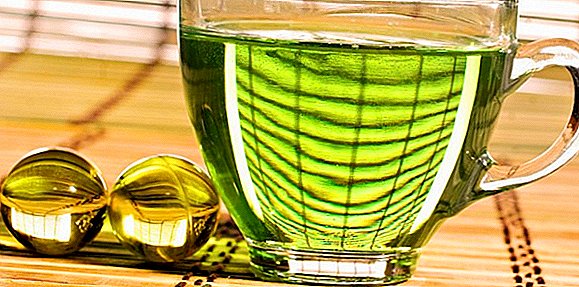
Learn how to deal with pests of roses, sunflower, begonias, willow, horseradish, dieffenbachia, almonds, onions, cabbage, eggplant, peonies, currants, cucumbers, palm trees, kalanchoe, thuja, azaleas, yuccas, pumpkins, asters, tangerine and dill.
Gallic nematode
Another scourge of greenhouses and crops growing nearby. Insidious for its tiny size.
How does it look
The micro-worm grows to 1, maximum 2 mm in length. These filamentous insects sometimes resemble a egg capsule in shape (which is typical for females that produce large offspring). 
What is dangerous
In the ground fall, mainly with infected seedlings. In such an environment, nematodes affect the tissues of rhizomes, which appear painfully thickened tubers.
Did you know? Incas and Aztecs began to cultivate tomatoes in the VIII century. They called this plant "matl".At the same time the tomato lags behind in growth, begins to wither. From the outside, it seems that he lacks moisture or supplements. If such insertions do not help, there are two ways out - dig a bush or process it at the beginning of the invasion.
How to fight
The range of drugs is very limited - the most powerful compounds that destroy the worm are simply forbidden for use in suburban areas. But there is a way out. Help in the fight will be:
- Fitoverm. The frequency of application is the same as in the case of whitefly, but the dose is often adjusted (instead of 10 g per 1 l of water, 12-13 are added);
- garlic infusion.
Read also how to get rid of whitefly, nematodes, Colorado potato beetle, cockchafer, Medvedka, spider mite, wireworm, moths, slugs and aphids.
Colorado beetle
This potato lover is known to all. Although no less attractive target for the insect are the close rows with tomatoes. 
How does it look
Orange larvae grow as they grow from barely noticeable orange dots in orange insects that look like short but fat worms. Adults can grow up to 1.2-1.5 cm in length with a width of 7 mm. Their little body and head with antennae are yellow, and on each gray-white wing there are 5 black stripes.
What is dangerous
In "Colorado" no enemies among insects and animals. Their destruction is complicated by the presence of wings - these parasites easily fly over fairly long distances.
Important! The Colorado potato beetle is frightened away by legumes, garlic, nasturtium and calendula growing near tomatoes.Eat the leaves, and goes to the stalks. When large quantities seriously threaten the future harvest. Moreover, if you do not fight them, the striped ones winter in the same area and appear in an even greater mass during the warm season.
We grow tomatoes in the greenhouse, and in open ground.
How to fight
Usually take the same drugs as for the protection of potatoes. But tomatoes have their own specifics. Practice shows that such means are most effective:
- Aktara. For radical irrigation - 8g / 10 l of water. Spraying - bag (1.4 g) is pre-mixed with 2 liters of water. Then the sprayer itself is a quarter filled with water, adding 200 g of solution. After stirring, add more water (until it turns out 5 l). The effect lasts 3-5 weeks;
- Mospilan 5-8 g for the same volume of water, with a large accumulation of the beetle, another treatment is carried out after 2-3 weeks;

- Prestige, which is used even before the laying of seedlings. It is most convenient to work with a syringe - 2 "cubes" per 1 liter of water, and the roots are immersed for 5-8 hours (make sure that the stems do not get into the solution);
- ash and soap. 1 kg of wood ash is poured with water (the same 10 l). A day later, add 40 g of worn soap. The mixture is used for spraying. He is brought to full readiness no more than an hour before the procedure.

Did you know? Colorado beetles came to Europe (or rather, to Germany) in the late 1870s, and eventually spread across the continent. Surprisingly, the striped attack has passed Britain - an insect is extremely rare there.Most other “potato” chemicals are also suitable, but they require accuracy in doses (norms for different crops are usually indicated on the package).
Maybot larvae (Khrushchev)
Keep up with other pests and crunches. Especially cunning is their young in the form of numerous larvae.
What do they look like
This is a rather large insect - the larva may be 4-5 in length, and even up to 7 cm. The wrinkled body of a milky yellow color is crowned with a reddish head with antennae and conspicuous chews. In front of the body are three pairs of legs. On the sides are visible row light brown markings. At rest, it twists and resembles the letter "C" in shape. 
Than dangerous
Lead an underground lifestyle. Living in rather large (up to 0.5 m) depths, in search of food, they rise higher, damaging the roots. Can get out and out, while eating the stems. A large colony can completely destroy the seedlings in a small area.
Check out the top 10 sweetest tomato varieties.
How to fight
Folk methods like digging up the soil with the subsequent removal of the larvae are laborious and do not always give results.
The chemical compositions used for soaking seedlings are more appropriate:
- Aktara-25. Before planting, the rhizome is placed in a 0.25% solution for 3 hours;
- Antihrusch (10 ml / 10 l of water). Hold 45 minutes, maximum hour;
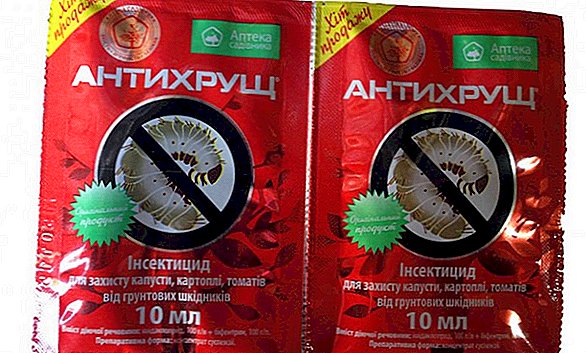
- Prestige. 30 ml / 3 l, but soaking lasts already 7-8 hours.
 If the Khrushka appeared on the surface or in the top layer of soil on the eve of planting, it will be useful:
If the Khrushka appeared on the surface or in the top layer of soil on the eve of planting, it will be useful:
- Basudin. Taking a container with a volume of 1 l, it is на filled with dry sand, filling up the contents of the package (30 g). All this is mixed and introduced into the landing pits, 1 tsp each;

- Rembek in the form of granules. A week before disembarking, in places of probable appearance, 2-4 g are laid down, to a depth of 5 cm. Distance: 0.5-0.7 m. If there are crinkles, another treatment is carried out in mid-June.

Important! Mulching also helps to protect bushes from crunching: chopped straw, shavings and crushed bark are used.During the growing season, try to use homemade tools like:
- solution of onion peel. 100 g / 10 l, 5-day sludge. The liquid is diluted with water in equal parts and used for irrigation and spraying;
- a weak solution of potassium permanganate, which is sprayed under the leaves.
Medvedka
Because of its behavior, the insect is considered a real monster, causing damage to tomato arrays, and the rest of the plants too.
How does it look
Large (about 5 cm) individuals of brown-brown color with a hard body. They are distinguished by strong front and wide-set hind legs. The powerful head with horny jaws also has a noticeable mustache. The wings of the bear are designed so that they allow free movement throughout the site. 
What is dangerous
Medvedka settles at shallow (up to 15-20 cm) depths and affects mainly the roots. It happens that it is chosen outward and gnaws the stems, thereby bringing the damaged plant to death.
How to fight
There is little sense from outside spraying - it is possible to remove this attack only by laying special granules.
Learn more about tomato diseases such as Fusarium, Alternaria, Top Rot and Powdery Mildew.Best proven themselves:
- Bankol;
- Grizzly;
- Thunder;
- Medvetoks;
- Rembek;
- Initiative.
Did you know? Botanists consider tomato a berry, and in the EU countries this is recognized at the legislative level.Depths and doses are indicated on packages and may vary depending on soil composition and pest population.
 Folk agricultural technology uses the following methods:
Folk agricultural technology uses the following methods:- soil treatment with liquid ammonia - the medvedka does not tolerate it. The method is simple, but somewhat controversial: ammonia evaporates in 2-3 days, and in large doses is harmful for tomatoes;
- sharing on the site digging wasps. This is an environmentally friendly method - such wasps, finding a pest's nest, drive the enemy out and paralyze him. After a while, the bear dies;
- early spring lay bait. To do this, steamed grains of wheat, rye, or corn are sprinkled with aldrin (50 g of powder per 1 kg of the preform);
- the detected passages are poured with foamed water (10 g of laundry soap or 50 g of laundry detergent per 10 l);
- fall helps dung traps. In small, to the depth of the spade bayonet, the pits lay manure. Medvedki willingly go there and with the first frost fall into a dream. Then scatter all the muck, and insects die.
We recommend that you learn how to harvest tomatoes for the winter.
Spider mite
Food-neutral pest is a real headache for gardeners. He can literally fall from the sky, hitting tomatoes from an apple tree or other trees.
How does it look
The size of the parasite is from 0.2 to 2 mm. The oval-shaped soft body is usually solid, although it can be divided into 2 parts (the back one is larger). The lower half of the body is flat, and the top is convex.
Important! In agro shops, paper sachets are sold in which natural antagonists of this species are placed - predatory amblyseius and phytoseiulus. These are also ticks, but they eat the spider webs without causing any special harm to the bush. Opened sachets expose directly to the plant.An adult tick has 4 pairs of legs. Color varies: there are gray, green, red or completely colorless ticks.
What is dangerous
Almost weightless pests are easily carried by the wind, creating a threat to plants. A lot of them among the remnants of old plants. Settling on the bushes of tomatoes, damage the leaves. This leads to blotchy wilting, mosaic plate damage and viral dithering (striacle). With a large cluster provoke the appearance of gray rot.
How to fight
The list of drugs for the destruction of the tick looks like this:
- Fitoderm (traditional 10g / 1 l) and double spraying during the growing season with a mandatory break of 2 weeks;
- Agrovertin and Karbofosthat help with large volumes of damage. The dose is described in the instructions, but in any case between 2 approaches withstand a 3-week interval;
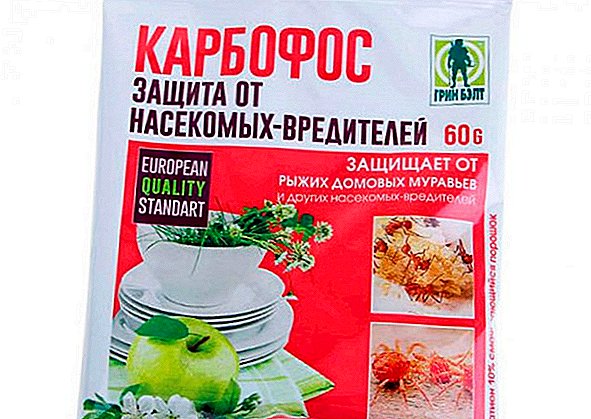
- Barrier. 3 tablespoons / 10 liters of water. A small colony of mites will not withstand a single spraying;
- Barrier. 2 dimensional caps are added to 1 liter of water, and the leaves are well sprayed until they are wet. Repeat - after 3 weeks, if necessary, make additional approaches (7-10 days after the main course).
- soap solution;
- rubbing leaves with a cotton swab moistened with medical alcohol;
- cat flea drops. 3-4 drops / 10 l of water and can be sprayed. The procedure is repeated after 10 days.
Wireworm
Many take it for a worm, but in fact it is a larva of a click beetle. Learn how to get rid of such a "guest." 
How does it look
The length of the larva is from 1 to 5 cm.
Did you know? All insects (with the exception of the praying mantis) cannot turn their heads: they have to turn the whole body for a review.The body is very thin and hard, to crush this pest is unrealistic. Color can be both yellow and dark brown. The paws are short, but the jaws are powerful: they gnaw through any parts of the plants.
What is dangerous
Unlike the adult, the larva can live 3-4 seasons, causing considerable damage. Living in the ground, they mainly damage the roots, although it occasionally falls on the stems with leaves. But the main problem lies in the vitality and activity of this species.
How to fight
The arsenal of means and preparations is identical to the set used for the extermination of crunches. But in this case, a crucial role is given to prevention.  For such purposes, use:
For such purposes, use:
- Superphosphate in the form of granules treated with Decis, Aktellikolm or Karate. Lay before planting, 3-4 pieces per well;
- herbal infusions of different recipes. 100 g of celandine can be added to 10 liters of water (as an option, 200 g of dandelion or half a kilo of nettle). Celandine insist 3 days, and all other additives - 12 hours. The liquid is prepared at the time of planting and poured into the wells;
- As prevention in early spring, the crumpled egg shells are scattered around the site.
Sprout fly
Distributed everywhere, especially many of these insects near the deciduous forests.
How does it look
The average larva (5-7 mm) at the beginning of life is almost transparent, with time it becomes more fleshy and acquires a dirty gray color. The front edge is narrowed, with 4 mouth hooks. 
Important! In a temperate climate, three generations of flies change over the season: the “second” larvae develop in June, and the third generation - at the end of July. During these periods, it is worth looking more closely at not only tomatoes, but also neighboring plants.The adult individual is not much larger: up to 6 mm. It is characterized by a yellow-gray color, brown back with 3 brown stripes and a gray belly with a longitudinal black stripe. On the head there is also a light orange mark.
What is dangerous
The greatest damage is caused by the larvae eating the roots and young shoots. Adult flies are very dangerous for tomatoes: the leaves are damaged, and from the tips of the paws to the green mass are brought various infections, including fungal infections, such as late blight.
How to fight
Lime larvae and reduce the number of flies within the garden can be using:
- Sparks. The drug is used in the same doses as in the case of whitefly;
- preparations based on the substance malathion (Funanon, Karbofos);
- Flies well repels a mixture of tobacco dust and bitter pepper (1 tsp.), added to 200 g of sifted ash. The figures are based on 1 sq.m. Bring directly into the aisle, not forgetting to loosen the ground.
Scoops
This is a whole family of pests, of which the most known are the three lines, namely winter, potato and garden. This triad annually delivers a lot of trouble, and especially the caterpillars annoy. 
What do they look like
They are very similar to each other and differ only in details. So, winter caterpillars have an earthy gray color. Greenish color is less common, and then visible dark stripes with thick gleam are visible. Length - up to 5-5,2 cm.
Did you know? Среди насекомых тоже попадаются меломаны. Доказано, что термиты, едва уловив звуки резкой и динамичной музыки вроде heavy metal, начинают грызть дерево вдвое быстрее.The potato variety is slightly smaller (4 cm), has a more varied color: from lemon yellow to burgundy, with a scarlet stripe on its side. Garden scoops at the caterpillar stage grow up to 3-4 cm. These are insects of light green color with a yellow side strip and thin yellow lines running across the body segments.
Than dangerous
These species are omnivorous, but in the case of tomatoes there are unpleasant features:
- winter scoop gnaws stalks at ground level and is particularly voracious;

- garden destroys the flesh of the leaf or gnaws through it. Immature fruits also suffer;
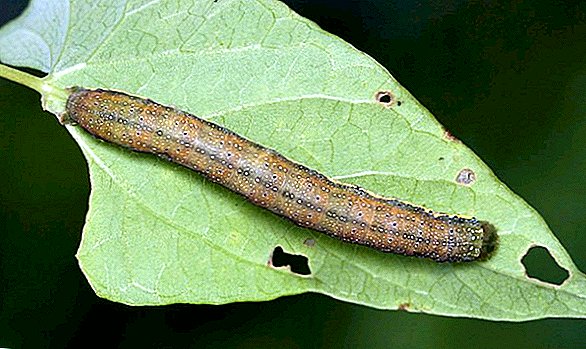
- potato where it is more cunning - gnawing through the moves inside the stem, it thereby kills the bush, which falls under the weight of the green mass.
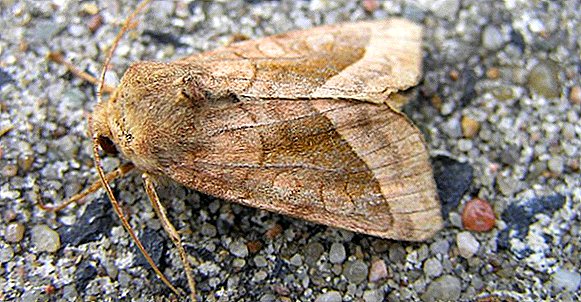
How to fight
The easiest way to take insecticides is more powerful. They are used only during the growing season:
- Inta-Vir. In a 10-liter container with water add 1 tablet. One processing should be enough;

- Decis Expert. For spraying 1 weave will need 1 g of the drug in a mixture with 3 liters of water;
- Arrivo. The volume is the same, but you need 3 g;
- Lepizodid. The dose depends on the activity of pests: when a large number of caterpillars make a solution at the rate of 70 g / 4 l of water. If the scoops did not have time to breed, but the situation is alarming, the drug needs half as much.

Important! Be careful with any chemicals. In no case do not dilute the purchased formulations in enclosed spaces.
From folk remedies scoops do not tolerate treatments involving:
- infusion on garlic shooters. 500 g of crushed processes are placed in a 3-liter bottle, filled with water on the edge. After a week of sludge should be decanting. Before spraying, 50-60 g of the mixture and the same amount of washed soap are added to 10 l of water;
- decoction of wormwood. The recipe is different - 650-700 g of fresh collection is poured with boiling water (5 l). 3-4 days in a dark place and the tool is ready. With water diluted in a ratio of 1:10.
Slugs
This is another inhabitant of the garden, repelling one of its kind.
What do they look like
They look like a snail without a shell. Typically, the dimensions are within 4-8 cm, although there are giants up to 10. The color is light brown, brown, or with frequent patches of white dots. They are nocturnal, recalling their presence with mucous marks on plants. 
Than dangerous
Favorite delicacies - leaves and fruits (especially immature). Unlike more phlegmatic snails, they actively move around the site, which is why plants are at risk of becoming infected with fungal and putrefactive infections introduced by sick varieties.
How to fight
The most effective granules Ulicid. They are evenly scattered at the stems, in the aisle and along the paths. 3-5 grams per 1 sq.m. enough to make slugs smaller.
Did you know? Forest slug species adore amanita.Meta and Thunderstorm drugs have a similar effect: once in the stomach, they neutralize the slug. Because of their soft underbelly, these insects do not like rough surfaces - having scattered some sand or spruce needles, you will see that the pest simply did not reach the bushes. He also does not tolerate "hearty" infusions - garlic, mustard, or with the participation of bitter pepper.
Aphid
It is believed that the past few years, the aphid multiplies more actively than before, so you have to intensively destroy it. 
How does it look
Insect with dimensions of 1-2.5 mm has a yellow, dark green, rarely brown color. The belly is yellowish or swamp green. It is distinguished by its mustache (they sometimes have 2/3 of the entire length) and yellow paws. The larvae are slightly smaller, their color is lighter.
What is dangerous
Tomatoes of cotton or potato aphid are more susceptible to tomatoes growing in greenhouses. By the nature of the damage caused by an insect close to the whitefly. The “handwriting” is the same: parasitism on leaves and stems (losing sap, they become relief and dry), hazardous excretion products favorable for the development of fungal rot, and, finally, the transfer of other diseases. In southern areas, aphid harms and in the open field.
How to fight
The same preparations and infusions are used as with the elimination of whitefly - Fitoverm, Spark, Aktar, garlic and soap compositions.
Important! In order not to leave a chance, in the spring (even before planting) the plot for tomatoes is treated with Karbofos. A dill or celery planted in the aisle will scare the insect away.You can add the emulsion of phosphamide in a concentration of 0.1-0.2%. To 20 ml on 10 l of water, and means for spraying of leaves is ready. Required break in 2 weeks. True, there is a nuance: the last approach is made a month before harvesting.
Make a tomato jam, salad for the winter, and juice.We found out which insects are most dangerous for tomatoes, and what is needed to remove them from the site. We hope this data will help preserve the bushes of tomatoes and collect an impressive crop. Let the garden and everything connected with it bring you only joy!
Video: how to deal with aphids
Reviews from the network:
And if the midge is white, then it is most likely a whitefly. This, of course, is still a contagion, but you can withdraw it. You can use the drug Aktara, quite an effective means. The lower part of the leaves, where a large number of pests cling, spray with water. Traditional soap solutions, onion peel somehow do not work very well. Although chemistry is not necessary to abuse.Nika
//indasad.ru/forum/31-vrediteli-i-bolezni/2485-bolezni-i-vrediteli-tomatov #2538



















